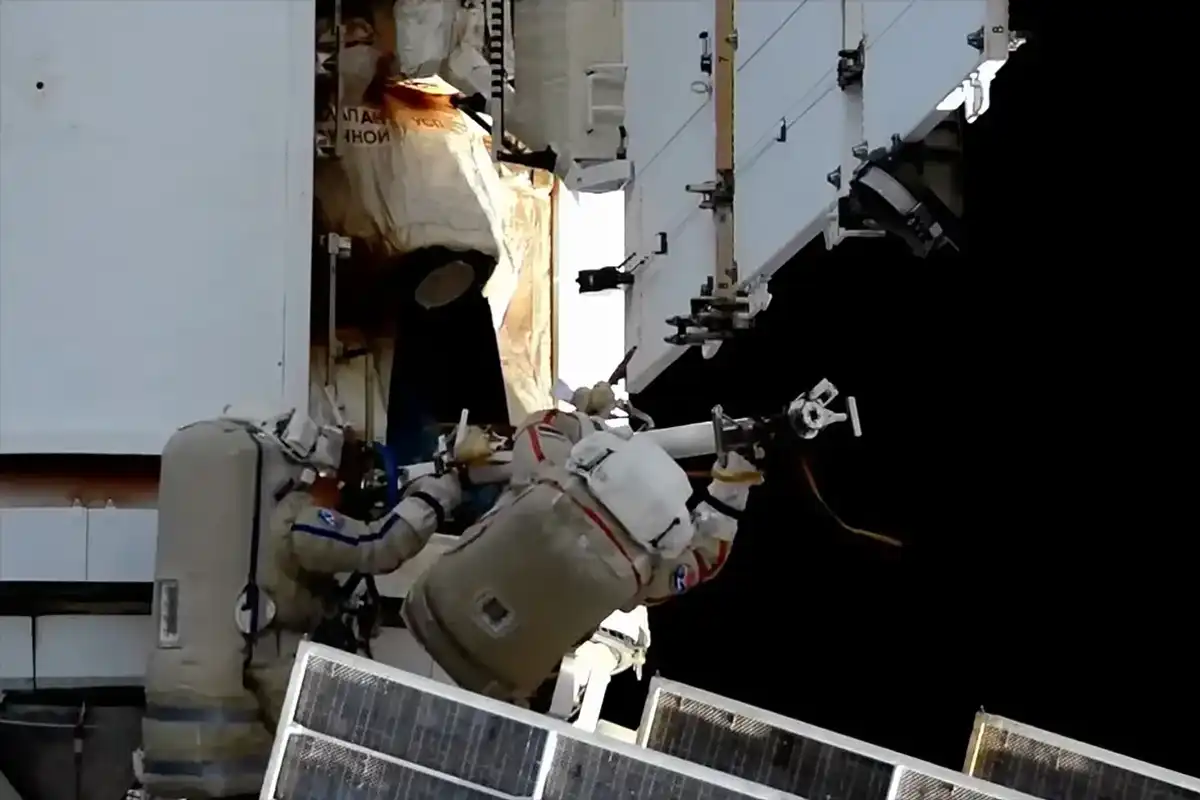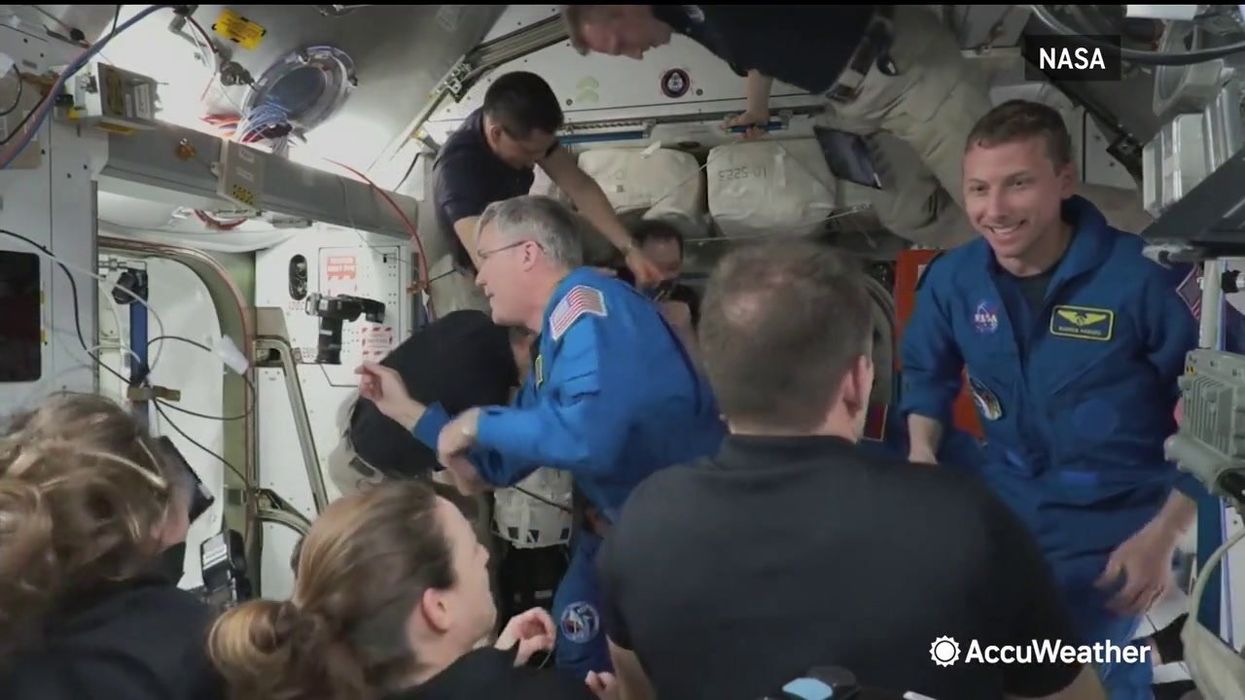Science & Tech
Harriet Brewis
Jun 22, 2025
What is life like on board the International Space Station and in …
AccuWeather / VideoElephant
If there’s one thing astronauts don’t want to face when out in the endless expanse of space, it’s signs that their station is being sabotaged.
And yet, cosmonauts Oleg Kononenko and Nikolai Chubwere forced to face a strange phenomenon during a spacewalk in October 2023.
The pair exited the International Space Station (ISS) on to fix a radiator which had sprung a leak. And while they were out, they were met by a close encounter of a very strange kind.
Inspecting the source of the leak during their outing, Kononenko reported seeing a number of holes on the radiator panel.
"The holes have very even edges, like they've been drilled through," he told Moscow Mission Control, according to Space.com.
"There are lots of them. They are spread in a chaotic manner."

The cosmonauts were given tissues and cloths to soak up any fluid that had seeped out of the radiator, with the pool of liquid coolant described as a growing “blob”.
However, Kononenko got so close to the “blob” that one of his tethers became contaminated. This meant that it had to be bagged up and discarded outside the ISS before the cosmonauts could go back inside.
The external radiator was mounted on the outside of Russia’s Nauka module – home to a multipurpose laboratory – which was launched in 2021.
It was used as a backup to another radiator which regulates the temperature inside the lab.
Kononenko and Chub closed a number of valves to cut off the external radiator from its ammonia supply, and it’s believed that the “blob” formed from residual ammonia that was disturbed when the valves were being shut.
The toxic liquid certainly wouldn’t have been welcome on board the space station, hence why the two colleagues embarked upon their spacewalk armed with cloths to wipe down their spacesuits and tools.
[rebelmouse-image 50329030 expand=1 dam="0" alt="" site_id=24473854 is_animated_gif=false original_size="1200x795" crop_info="%7B%22image%22%3A%20%22https%3A//assets.rbl.ms/50329030/origin.jpg%22%2C%20%22thumbnails%22%3A%20%7B%22origin%22%3A%20%22https%3A//assets.rbl.ms/50329030/origin.jpg%22%2C%20%22980x%22%3A%20%22https%3A//www.indy100.com/media-library/eyJhbGciOiJIUzI1NiIsInR5cCI6IkpXVCJ9.eyJpbWFnZSI6Imh0dHBzOi8vYXNzZXRzLnJibC5tcy81MDMyOTAzMC9vcmlnaW4uanBnIiwiZXhwaXJlc19hdCI6MTcwNDcwMTg2Nn0.dG0ebWuMoU-ZpbGQQC0Czdyuxd67D639m60I2bPA1wE/image.jpg%3Fwidth%3D980%22%2C%20%221500x2000%22%3A%20%22https%3A//www.indy100.com/media-library/eyJhbGciOiJIUzI1NiIsInR5cCI6IkpXVCJ9.eyJpbWFnZSI6Imh0dHBzOi8vYXNzZXRzLnJibC5tcy81MDMyOTAzMC9vcmlnaW4uanBnIiwiZXhwaXJlc19hdCI6MTcwNDcwMTg2Nn0.dG0ebWuMoU-ZpbGQQC0Czdyuxd67D639m60I2bPA1wE/image.jpg%3Fwidth%3D1500%26height%3D2000%26coordinates%3D301%252C0%252C302%252C0%22%2C%20%221200x400%22%3A%20%22https%3A//www.indy100.com/media-library/eyJhbGciOiJIUzI1NiIsInR5cCI6IkpXVCJ9.eyJpbWFnZSI6Imh0dHBzOi8vYXNzZXRzLnJibC5tcy81MDMyOTAzMC9vcmlnaW4uanBnIiwiZXhwaXJlc19hdCI6MTcwNDcwMTg2Nn0.dG0ebWuMoU-ZpbGQQC0Czdyuxd67D639m60I2bPA1wE/image.jpg%3Fwidth%3D1200%26height%3D400%26coordinates%3D0%252C197%252C0%252C198%22%2C%20%22400x225%22%3A%20%22https%3A//www.indy100.com/media-library/eyJhbGciOiJIUzI1NiIsInR5cCI6IkpXVCJ9.eyJpbWFnZSI6Imh0dHBzOi8vYXNzZXRzLnJibC5tcy81MDMyOTAzMC9vcmlnaW4uanBnIiwiZXhwaXJlc19hdCI6MTcwNDcwMTg2Nn0.dG0ebWuMoU-ZpbGQQC0Czdyuxd67D639m60I2bPA1wE/image.jpg%3Fwidth%3D400%26height%3D225%26coordinates%3D0%252C60%252C0%252C60%22%2C%20%22600x%22%3A%20%22https%3A//www.indy100.com/media-library/eyJhbGciOiJIUzI1NiIsInR5cCI6IkpXVCJ9.eyJpbWFnZSI6Imh0dHBzOi8vYXNzZXRzLnJibC5tcy81MDMyOTAzMC9vcmlnaW4uanBnIiwiZXhwaXJlc19hdCI6MTcwNDcwMTg2Nn0.dG0ebWuMoU-ZpbGQQC0Czdyuxd67D639m60I2bPA1wE/image.jpg%3Fwidth%3D600%22%2C%20%22300x300%22%3A%20%22https%3A//www.indy100.com/media-library/eyJhbGciOiJIUzI1NiIsInR5cCI6IkpXVCJ9.eyJpbWFnZSI6Imh0dHBzOi8vYXNzZXRzLnJibC5tcy81MDMyOTAzMC9vcmlnaW4uanBnIiwiZXhwaXJlc19hdCI6MTcwNDcwMTg2Nn0.dG0ebWuMoU-ZpbGQQC0Czdyuxd67D639m60I2bPA1wE/image.jpg%3Fwidth%3D300%26height%3D300%26coordinates%3D202%252C0%252C203%252C0%22%2C%20%222000x1500%22%3A%20%22https%3A//www.indy100.com/media-library/eyJhbGciOiJIUzI1NiIsInR5cCI6IkpXVCJ9.eyJpbWFnZSI6Imh0dHBzOi8vYXNzZXRzLnJibC5tcy81MDMyOTAzMC9vcmlnaW4uanBnIiwiZXhwaXJlc19hdCI6MTcwNDcwMTg2Nn0.dG0ebWuMoU-ZpbGQQC0Czdyuxd67D639m60I2bPA1wE/image.jpg%3Fwidth%3D2000%26height%3D1500%26coordinates%3D70%252C0%252C70%252C0%22%2C%20%22600x200%22%3A%20%22https%3A//www.indy100.com/media-library/eyJhbGciOiJIUzI1NiIsInR5cCI6IkpXVCJ9.eyJpbWFnZSI6Imh0dHBzOi8vYXNzZXRzLnJibC5tcy81MDMyOTAzMC9vcmlnaW4uanBnIiwiZXhwaXJlc19hdCI6MTcwNDcwMTg2Nn0.dG0ebWuMoU-ZpbGQQC0Czdyuxd67D639m60I2bPA1wE/image.jpg%3Fwidth%3D600%26height%3D200%26coordinates%3D0%252C197%252C0%252C198%22%2C%20%221200x600%22%3A%20%22https%3A//www.indy100.com/media-library/eyJhbGciOiJIUzI1NiIsInR5cCI6IkpXVCJ9.eyJpbWFnZSI6Imh0dHBzOi8vYXNzZXRzLnJibC5tcy81MDMyOTAzMC9vcmlnaW4uanBnIiwiZXhwaXJlc19hdCI6MTcwNDcwMTg2Nn0.dG0ebWuMoU-ZpbGQQC0Czdyuxd67D639m60I2bPA1wE/image.jpg%3Fwidth%3D1200%26height%3D600%26coordinates%3D0%252C97%252C0%252C98%22%2C%20%221200x800%22%3A%20%22https%3A//www.indy100.com/media-library/eyJhbGciOiJIUzI1NiIsInR5cCI6IkpXVCJ9.eyJpbWFnZSI6Imh0dHBzOi8vYXNzZXRzLnJibC5tcy81MDMyOTAzMC9vcmlnaW4uanBnIiwiZXhwaXJlc19hdCI6MTcwNDcwMTg2Nn0.dG0ebWuMoU-ZpbGQQC0Czdyuxd67D639m60I2bPA1wE/image.jpg%3Fwidth%3D1200%26height%3D800%26coordinates%3D3%252C0%252C4%252C0%22%2C%20%2235x35%22%3A%20%22https%3A//www.indy100.com/media-library/eyJhbGciOiJIUzI1NiIsInR5cCI6IkpXVCJ9.eyJpbWFnZSI6Imh0dHBzOi8vYXNzZXRzLnJibC5tcy81MDMyOTAzMC9vcmlnaW4uanBnIiwiZXhwaXJlc19hdCI6MTcwNDcwMTg2Nn0.dG0ebWuMoU-ZpbGQQC0Czdyuxd67D639m60I2bPA1wE/image.jpg%3Fwidth%3D35%26height%3D35%22%2C%20%22210x%22%3A%20%22https%3A//www.indy100.com/media-library/eyJhbGciOiJIUzI1NiIsInR5cCI6IkpXVCJ9.eyJpbWFnZSI6Imh0dHBzOi8vYXNzZXRzLnJibC5tcy81MDMyOTAzMC9vcmlnaW4uanBnIiwiZXhwaXJlc19hdCI6MTcwNDcwMTg2Nn0.dG0ebWuMoU-ZpbGQQC0Czdyuxd67D639m60I2bPA1wE/image.jpg%3Fwidth%3D210%22%2C%20%22750x1000%22%3A%20%22https%3A//www.indy100.com/media-library/eyJhbGciOiJIUzI1NiIsInR5cCI6IkpXVCJ9.eyJpbWFnZSI6Imh0dHBzOi8vYXNzZXRzLnJibC5tcy81MDMyOTAzMC9vcmlnaW4uanBnIiwiZXhwaXJlc19hdCI6MTcwNDcwMTg2Nn0.dG0ebWuMoU-ZpbGQQC0Czdyuxd67D639m60I2bPA1wE/image.jpg%3Fwidth%3D750%26height%3D1000%26coordinates%3D301%252C0%252C302%252C0%22%2C%20%22600x400%22%3A%20%22https%3A//www.indy100.com/media-library/eyJhbGciOiJIUzI1NiIsInR5cCI6IkpXVCJ9.eyJpbWFnZSI6Imh0dHBzOi8vYXNzZXRzLnJibC5tcy81MDMyOTAzMC9vcmlnaW4uanBnIiwiZXhwaXJlc19hdCI6MTcwNDcwMTg2Nn0.dG0ebWuMoU-ZpbGQQC0Czdyuxd67D639m60I2bPA1wE/image.jpg%3Fwidth%3D600%26height%3D400%26coordinates%3D3%252C0%252C4%252C0%22%2C%20%22700x1245%22%3A%20%22https%3A//www.indy100.com/media-library/eyJhbGciOiJIUzI1NiIsInR5cCI6IkpXVCJ9.eyJpbWFnZSI6Imh0dHBzOi8vYXNzZXRzLnJibC5tcy81MDMyOTAzMC9vcmlnaW4uanBnIiwiZXhwaXJlc19hdCI6MTcwNDcwMTg2Nn0.dG0ebWuMoU-ZpbGQQC0Czdyuxd67D639m60I2bPA1wE/image.jpg%3Fwidth%3D700%26height%3D1245%26coordinates%3D376%252C0%252C376%252C0%22%2C%20%221245x700%22%3A%20%22https%3A//www.indy100.com/media-library/eyJhbGciOiJIUzI1NiIsInR5cCI6IkpXVCJ9.eyJpbWFnZSI6Imh0dHBzOi8vYXNzZXRzLnJibC5tcy81MDMyOTAzMC9vcmlnaW4uanBnIiwiZXhwaXJlc19hdCI6MTcwNDcwMTg2Nn0.dG0ebWuMoU-ZpbGQQC0Czdyuxd67D639m60I2bPA1wE/image.jpg%3Fwidth%3D1245%26height%3D700%26coordinates%3D0%252C60%252C0%252C60%22%2C%20%221000x750%22%3A%20%22https%3A//www.indy100.com/media-library/eyJhbGciOiJIUzI1NiIsInR5cCI6IkpXVCJ9.eyJpbWFnZSI6Imh0dHBzOi8vYXNzZXRzLnJibC5tcy81MDMyOTAzMC9vcmlnaW4uanBnIiwiZXhwaXJlc19hdCI6MTcwNDcwMTg2Nn0.dG0ebWuMoU-ZpbGQQC0Czdyuxd67D639m60I2bPA1wE/image.jpg%3Fwidth%3D1000%26height%3D750%26coordinates%3D70%252C0%252C70%252C0%22%2C%20%22300x%22%3A%20%22https%3A//www.indy100.com/media-library/eyJhbGciOiJIUzI1NiIsInR5cCI6IkpXVCJ9.eyJpbWFnZSI6Imh0dHBzOi8vYXNzZXRzLnJibC5tcy81MDMyOTAzMC9vcmlnaW4uanBnIiwiZXhwaXJlc19hdCI6MTcwNDcwMTg2Nn0.dG0ebWuMoU-ZpbGQQC0Czdyuxd67D639m60I2bPA1wE/image.jpg%3Fwidth%3D300%22%2C%20%22600x300%22%3A%20%22https%3A//www.indy100.com/media-library/eyJhbGciOiJIUzI1NiIsInR5cCI6IkpXVCJ9.eyJpbWFnZSI6Imh0dHBzOi8vYXNzZXRzLnJibC5tcy81MDMyOTAzMC9vcmlnaW4uanBnIiwiZXhwaXJlc19hdCI6MTcwNDcwMTg2Nn0.dG0ebWuMoU-ZpbGQQC0Czdyuxd67D639m60I2bPA1wE/image.jpg%3Fwidth%3D600%26height%3D300%26coordinates%3D0%252C97%252C0%252C98%22%2C%20%22600x600%22%3A%20%22https%3A//www.indy100.com/media-library/eyJhbGciOiJIUzI1NiIsInR5cCI6IkpXVCJ9.eyJpbWFnZSI6Imh0dHBzOi8vYXNzZXRzLnJibC5tcy81MDMyOTAzMC9vcmlnaW4uanBnIiwiZXhwaXJlc19hdCI6MTcwNDcwMTg2Nn0.dG0ebWuMoU-ZpbGQQC0Czdyuxd67D639m60I2bPA1wE/image.jpg%3Fwidth%3D600%26height%3D600%26coordinates%3D202%252C0%252C203%252C0%22%2C%20%221200x795%22%3A%20%22https%3A//www.indy100.com/media-library/eyJhbGciOiJIUzI1NiIsInR5cCI6IkpXVCJ9.eyJpbWFnZSI6Imh0dHBzOi8vYXNzZXRzLnJibC5tcy81MDMyOTAzMC9vcmlnaW4uanBnIiwiZXhwaXJlc19hdCI6MTcwNDcwMTg2Nn0.dG0ebWuMoU-ZpbGQQC0Czdyuxd67D639m60I2bPA1wE/image.jpg%3Fwidth%3D1200%26height%3D795%26coordinates%3D0%252C0%252C0%252C0%22%7D%2C%20%22manual_image_crops%22%3A%20%7B%22custom%22%3A%20%7B%22sizes%22%3A%20%5B%221200x795%22%5D%2C%20%22top%22%3A%200%2C%20%22height%22%3A%20795%2C%20%22width%22%3A%201200%2C%20%22left%22%3A%200%7D%2C%20%222x1%22%3A%20%7B%22sizes%22%3A%20%5B%221200x600%22%2C%20%22600x300%22%5D%2C%20%22top%22%3A%2097%2C%20%22height%22%3A%20600%2C%20%22width%22%3A%201200%2C%20%22left%22%3A%200%7D%2C%20%223x1%22%3A%20%7B%22sizes%22%3A%20%5B%221200x400%22%2C%20%22600x200%22%5D%2C%20%22top%22%3A%20197%2C%20%22height%22%3A%20400%2C%20%22width%22%3A%201200%2C%20%22left%22%3A%200%7D%2C%20%223x2%22%3A%20%7B%22sizes%22%3A%20%5B%221200x800%22%2C%20%22600x400%22%5D%2C%20%22top%22%3A%200%2C%20%22height%22%3A%20795%2C%20%22width%22%3A%201193%2C%20%22left%22%3A%203%7D%2C%20%224x3%22%3A%20%7B%22sizes%22%3A%20%5B%222000x1500%22%2C%20%221000x750%22%5D%2C%20%22top%22%3A%200%2C%20%22height%22%3A%20795%2C%20%22width%22%3A%201060%2C%20%22left%22%3A%2070%7D%2C%20%223x4%22%3A%20%7B%22sizes%22%3A%20%5B%221500x2000%22%2C%20%22750x1000%22%5D%2C%20%22top%22%3A%200%2C%20%22height%22%3A%20795%2C%20%22width%22%3A%20597%2C%20%22left%22%3A%20301%7D%2C%20%221x1%22%3A%20%7B%22sizes%22%3A%20%5B%22600x600%22%2C%20%22300x300%22%5D%2C%20%22top%22%3A%200%2C%20%22height%22%3A%20795%2C%20%22width%22%3A%20795%2C%20%22left%22%3A%20202%7D%2C%20%229x16%22%3A%20%7B%22sizes%22%3A%20%5B%22700x1245%22%5D%2C%20%22top%22%3A%200%2C%20%22height%22%3A%20795%2C%20%22width%22%3A%20448%2C%20%22left%22%3A%20376%7D%2C%20%2216x9%22%3A%20%7B%22sizes%22%3A%20%5B%221245x700%22%2C%20%22400x225%22%5D%2C%20%22top%22%3A%2060%2C%20%22height%22%3A%20675%2C%20%22width%22%3A%201200%2C%20%22left%22%3A%200%7D%7D%7D" image_crop="3x2" pin_description="" caption="The growing "blob"\u00a0of ammonia coolant (circled in red) formed between the\u00a0radiator's panels" photo_credit=""] The growing "blob" of ammonia coolant (circled in red) formed between the radiator's panels
Russian engineers on the ground will use the data they collected to further investigate the cause of the leak and figure out how to fix the radiator.
The question now is will they be able to work out where those mysterious little holes came from?
This article was originally published on 29 October 2023
Why not read...
AI 'cannot understand' language at all
Second 'hidden city' discovered under Giza's pyramids
Sign up for our free Indy100 weekly newsletter
Have your say in our news democracy. Click the upvote icon at the top of the page to help raise this article through the indy100 rankings
Top 100
The Conversation (0)














